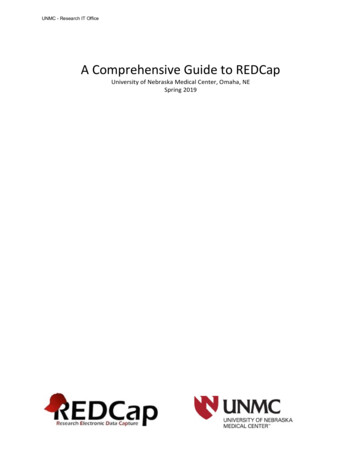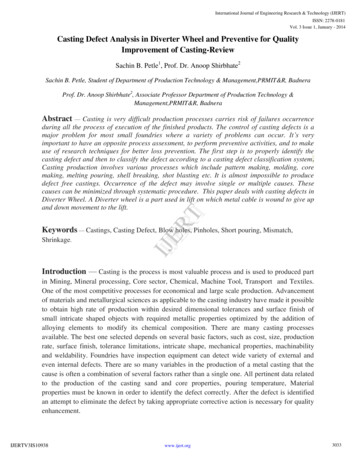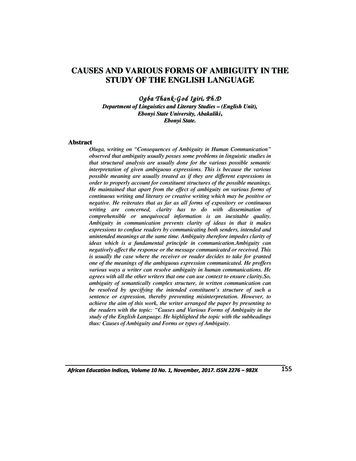
Transcription
CAUSES AND VARIOUS FORMS OF AMBIGUITY IN THESTUDY OF THE ENGLISH LANGUAGEOgba ThankThank - God Igiri, Ph.DDepartment of Linguistics and Literary Studies – (English Unit),Ebonyi State University, Abakaliki,Ebonyi State.AbstractOluga, writing on “Consequences of Ambiguity in Human Communication”observed that ambiguity usually posses some problems in linguistic studies inthat structural analysis are usually done for the various possible semanticinterpretation of given ambiguous expressions. This is because the variouspossible meaning are usually treated as if they are different expressions inorder to properly account for constituent structures of the possible meanings.He maintained that apart from the effect of ambiguity on various forms ofcontinuous writing and literary or creative writing which may be positive ornegative. He reiterates that as far as all forms of expository or continuouswriting are concerned, clarity has to do with dissemination ofcomprehensible or unequivocal information is an inexitable quality.Ambiguity in communication prevents clarity of ideas in that it makesexpressions to confuse readers by communicating both senders, intended andunintended meanings at the same time. Ambiguity therefore impedes clarity ofideas which is a fundamental principle in communication.Ambiguity cannegatively affect the response or the message communicated or received. Thisis usually the case where the receiver or reader decides to take for grantedone of the meanings of the ambiguous expression communicated. He proffersvarious ways a writer can resolve ambiguity in human communications. Heagrees with all the other writers that one can use context to ensure clarity.So,ambiguity of semantically complex structure, in written communication canbe resolved by specifying the intended constituent’s structure of such asentence or expression, thereby preventing misinterpretation. However, toachieve the aim of this work, the writer arranged the paper by presenting tothe readers with the topic: “Causes and Various Forms of Ambiguity in thestudy of the English Language. He highlighted the topic with the subheadingsthus: Causes of Ambiguity and Forms or types of Ambiguity.African Education Indices, Volume 10 No. 1, November, 2017. ISSN 2276 – 982X155
Ogba ThankThank - G od Igiri, Ph.DIt is a universally recognized and demonstratable fact that many of theacceptable utterances of English and other languages are ambiguous. They can beinterpreted in two or more different forms (Lyons 1978).This study therefore aims at discussing the causes and various forms ofAmbiguity in the study of the English Language. So, ambiguity having more than onemeaning, may be as a result of syntax or semantics. There are other forms or types ofambiguity such as:1. Lexical Ambiguity2. Structural Ambiguity3. Syntactic Ambiguity4. Semantic Ambiguity5. Grammatical Ambiguity6. Phonological Ambiguity7. Pragmatic AmbiguityUllman (1962) identifies three main forms of ambiguity. According to him,they are Phonetic, Grammatical and Lexical ambiguities. Ambiguity may result inspeech from the phonetic structure of the sentence since the acoustic unit of connectedspeech is the breath group, it may happen that two breath groups made up of differentwords become homonymous and so ambiguity occurs. If this occurs often enough, itmay live a permanent mark on the language. Many grammatical forms, free as well asbound, are ambiguous. Some prefixes and suffixes have more than one meaning. forexample, the suffix “able” does not mean the same in desirable or readable as it doesin eatable, knowable, debatable. There are also homonymous prefixes and suffixes.The prefix “in” meaning “into” “towards” “upon” for example indent, inborn,inflame, has a homonym in the prefix in: – expressing negation or privation forexample inappropriate, inexperienced, inconclusive). ‘In’ flexional endings can beambiguous. Ullman considers the most important type of ambiguity as the one thatoccurs due to lexical factors. Ambiguity occurs when the same word may have two ormore different meanings – This situation is known as polysemy. For instance, the noun“board” may mean a thick plank, a table, food served at the table, persons sitting at thecouncil table and various other things.Two or more different words may sound identical.These are called homonyms,though some may be spelt differently. For instance- (waist – waste, court – caught).Both polysemy and homonyms may be accompanied by syntactical differences when aword belongs to several parts of speech, for instance “double” which can be anadjective, an adverb, a verb and a noun. These uses will differ not only in meaning butin grammatical functions. Homonyms also may come from different word classes, forexample, rebel (adjective), rebel (noun); import (noun), import (verb); Conduct (noun),Conduct (verb)African Education Indices, Volume 10 No. 1, November, 2017. ISSN 2276 – 982X156
Causes and Various Forms of Ambiguity in the Study of the English LanguageHowever, the writer of this paper aims at discussing causes and various formsof Ambiguity in the study of the English Language. He expresses the study under twomain subheadings thus;Causes of Ambiguity and Forms or Types of Ambiguity.Causes of Ambiguity:Some linguists and communication experts in their contribution to the study ofambiguity have identified causes of ambiguity.Cann (1994): states that ‘ambiguity can arise through (1) the ascription ofmultiple meanings to single words’. For instance "the mean's punch was impressive".Ambiguity occurs because the word "punch" may be interpreted as a drink or as anaction. (2) Lexemes whose word forms have this property are called homonyms andcan be subdivided into homophones where the forms of the lexemes sound the samebut may be written differently. For example "draft and draught" which can berepresented phonemically as /dra:ft/ and homographs for instance "minute" which arewritten the same way but pronounced differently. (3) Ambiguity can also arise throughthe assignment of different syntactic structures to a sentence. For example: ‘The strikewas called by radical lecturers and students’. In this sentence, the ambiguity resultsfrom the possibility of assigning two or more syntactic structures to a singlegrammatical string of words. It becomes necessary to know whether the adjective"radical" modifies the nominal phrase "lecturers and students", in which case both thestudent who called the strike are said to be radical but the political attitude of thestudents who did so is not specified. The major issue here is, the scope of the adjective,‘radical’. Scope is a primary source of ambiguity which involves not only adjectivesbut also conjunctions, like ‘and’, ‘or’ and quantifiers like ‘every’, ‘all’ and ‘some’.Apart from lexical ambiguity, there is structural ambiguity. This has its source in thesyntax of a language. There are other ambiguities that involve negation (not),quantification (every, some) and other elements like ‘sense’, which do not vary theirsyntactic position according to the reading of the sentence.Kaiz (1966 pp. 158-9) states that; Semantic ambiguity, as distinct from syntacticambiguity and phonological ambiguity, has its sourcein the homonym of words.Syntactic ambiguity occurs when a sentence has more than one underlying structure.Phonological ambiguity occurs when surface structures of different sentences are giventhe same phonological interpretation. Semantic ambiguity, on the other hand, occurswhen an underlying structure contains an ambiguous word or words that contribute to ortheir multiple senses to the meaning of the whole sentence to be used to make morethan one statement, request, query etc.Pink Thomas (1970) emphasizes that; A sentence can be ambiguous through badarrangement of words and clauses, that is a violationof the rule of proximity. Forexample; “this lift must onlybe used by the staff”. The vague use of pronouns-thisoccurs particularly in reported speech. For example; ‘he told his younger brotherAfrican Education Indices, Volume 10 No. 1, November, 2017. ISSN 2276 – 982X157
Ogba ThankThank - G od Igiri, Ph.Dthat he could not sleep because he was too busy at night’. Ambiguity arises becausewe do not know if "he" refers to "the speaker" or to his "younger brother". Theomission of necessary words and "insertion" of articles to certain sentences. Forexample: ‘The qualification for a teacher and lecturerare not the same’. The article"a" should be inserted before "lecturer" to show that two distinct persons are referredto.Akwanya (1976 P.78) agreeing with others, states that some lexical items playa pivotal role in the interpretation of a sentence and that the sentence may be subject tomore interpretation if the item is not sufficiently specified in the context. Forinstance the item "run" in the following sentence plays such a central role.‘Obiageli is running the race’. "Run" here may be interpreted to mean (1) contendingin a race (2) organizing a race.Fowler, H.W.(1974) apart from agreeing that the use of a word with two meanings in acontext makes for absurdity or uncertainty also lists other common causes of ambiguityas: the use of pronouns in such a way that the reader cannot be sure of their antecedents.For example:1.‘In the December previous to his raid on the Tower he was chief of a gangwho overpowering his attendants seized Mayor of Abuja in Yakubu Street whenreturning from a dinner party’. (His refers not to the preceding he, but to the Mayor)2. ‘If the baby does not feed on feed on fresh milk, boil it’.3. ‘John told Derek that he has passed the examinations’.In the last sentence does "he" in the sentence mean John or Derek, does "it" in sentence(2) refer to the milk or the baby. It cannot be assumed that readers will alwaysassociate a pronoun with the last noun but one can think of the baby as the antecedent ofit.Another cause of ambiguity is uncertainty ‘whether’ ‘shall’ or ‘will’, ‘should’ or‘would’ is used as a simple auxiliary or as implying volition or obligation. Example: ‘Itis of interest to note that even as a tiro in politics’, he should have taken his own line,failure to make clear the field of operation of a word or phrase for example; He needsmore suitable compassions, or a participle – ‘His dog might sometimes come toresemble the frightened and exhausted rabbit who in the end walks towards the stoatseeking to devour him or a relative’. Other subordinate clause, for example: ‘I accusedhim of having violated the principles of concentration of force which had resulted inher present failures’. Are so, a negative in a sentence can cause ambiguity. Forexample, ‘the hat was not sent because of information received’. The word "because"showing a negative clause is often a cause of ambiguity. Does "because" in thesubordinate disclaim the reason why a thing was done or does it give a reason why athing was not done.Furthermore, the placing of the word "even" wrongly can cause ambiguity. Itwill be seen in position of adverbs that their placing is a matter partly of idiom and partlyof sense. "Even" is one of those words whose placing is important to the sense.African Education Indices, Volume 10 No. 1, November, 2017. ISSN 2276 – 982X158
Causes and Various Forms of Ambiguity in the Study of the English LanguageFor example:1. ‘Even I did not see him on Monday’. This implies that I was more likely to see himthan anyone else was.2. ‘I did not even see him on Monday’ implies that I had expected not only to see himbut also to speak to him.3. ‘I did not see him even on Monday’ implies that he was the person expected to see.4. ‘I did not see him even on Monday’ implies that ‘Monday was the day on which Iexpected to see him’.The indiscriminate placing of adverbs can cause ambiguity. There is an importantdifference between these two sentences:1. ‘He did not win luckily’.2. He did not win, luckily.Doubt avoided by re-arranging the order of the second sentences as luckily, he did notwin.All adverbs need not be placed where there can be doubt what word they are modifyingbut some adverbs like ‘hardly’, ‘scarcely’, ‘almost’, ‘even’, and ‘only’, need special care.In some sentences ambiguity occurs because of faulty punctuation. It may bebecause a comma has been omitted or wrongly introduced. Example: ‘I am speakingto you Ugo’. There should be a comma after you so the sentence should be I amspeaking to you, Ugo. Consider the following: ‘She likes coffee and rolls in bed’. Ifcomma is introduced after coffee the sentence will have quite a different meaning.Omission of Vital Punctuations:This is a major factor responsible for ambiguity in human communication. This isbecause proper use of punctuation marks in most cases usually aids thecommunication or comprehension of writer's intended meaning. Hence, theomission of vital punctuations may not clarify intended meaning and thereby subjectcommunicator's expressions or ideas to double or multiple semantic interpretation.Example: ‘If you need a good car at the end of the month, bring your money’. Thissentence is capable of dual or double semantic interpretation because it is not properlypunctuated to indicate the intended meaning by putting a comma at the appropriate place.Use of Double or Multiple Referent Pronouns:This arises when a communicator uses a pronoun that can go with two or morenouns mentioned in a given expression i.e. where the pronoun has double or multiplenominal referents. Cook and Ayodele also identified the role of this key factor in semanticmultiplicityMultiple Class Membership of some VerbsAccording to Quirk, Greenbaum, Leech and Svartik (1981) say that this ispossible because some verbs can belong in some ways to different classes of verbs andAfrican Education Indices, Volume 10 No. 1, November, 2017. ISSN 2276 – 982X159
Ogba ThankThank - G od Igiri, Ph.Dthereby function grammatically in different ways. The problem in this kind of situationis that such multiple class membership can subject the various functional possibilitiesof the verbs to different semantic interpretations.Example: ‘She found him a reliable partner’. The verb found can be mono transitivelyused. When used mono-transitively we will have the SVOC sentence structure withthe meaning she discovered or realized that he was a reliable partner. When used ditransitively we will have the SVOO sentence structure with the sentence meaning she got a reliable partner for him.Another factor recognized by Arisop is peculiar to pre-modifying adjectivesthat usually have unique reference and cannot be further limited or restricted by such premodifying adjectives.Double or multiple semantic interpretations can be possible with the use of such premodifying non-restrictive adjective because they are not usually marked either bypunctuation in written communication or by intonation in spoken or oral verbalcommunication. A good expression that can illustrate this kind of ambiguity is The patriotic British citizens respect their unwritten constitution a lot. This can mean‘All the British citizens are patriotic and they respect their unwritten constitution’. Oronly the patriotic British citizens (not all citizens) 'respect their unwritten constitution alot.Hyphens can also cause ambiguity. The primary function of the hyphen is toindicate that two or more words are to be read together as a single word with its ownmeaning. It is always used in such phrasal compounds as stick - in - the -mud, ne'erdo-well, and sister -in-law. Some words can be left also without hyphens forinstance ‘post office’, ‘motor car’ but some cannot like ‘cross – word’ (puzzle)‘black-cap’ (the bird). The problem is, when a compound word is hyphenatedand when is it not. This accounts for the ambiguity by hyphens. Other examples are‘loophole’, ‘public house;, and ‘cocktail’. Some people place a hyphen between theword cocktail. Another problem is, whether there is any need for the hyphens oftenused in compound designation of rank or office such as ‘Attorney General’, ‘ViceAdmiral’, ‘Lord Lieutant’, etc. We discover that it is not easy to find a uniformprinciple underlying such decision that, we must hyphenate. There exists alinguistic gap.‘Field – officer’ is hyphenated but not ‘field Marshal’,‘Quartermaster-General’ but we do not hyphenate ‘Attorney General’. We have‘Commander-in-Chief’ but not ‘Secretary of State’. Some authoritative works ofreference may say that we must hyphenate Field Marshal but not Field-Officer. Anothercause of ambiguity is the use of dangling modifiers. Dangling modifiers are phrases thatdo not clearly and logically refer to a noun or pronoun. They usually appear at thebeginning of a sentence. Example: ‘While eating lunch in the cafeteria, the computermalfunctioned’.The sentence does not say who was eating lunch and suggests that the computer was.Sometimes they appear at the end of a sentence.African Education Indices, Volume 10 No. 1, November, 2017. ISSN 2276 – 982X160
Causes and Various Forms of Ambiguity in the Study of the English LanguageExample: ‘Riding bicycle can be dangerous when inexperienced’.The sentence does not say who is inexperienced. To know whether a phrase is adangling modifier, one should check if the subject of the independent clause is the nounor noun phrase-acting as the modifier. If not, the modifier is dangling.Example: ‘After finishing the research, the paper was easy to write’. The subject of theindependent clause is paper, but paper did not finish the research, so the modifier isdangling and the sentence needs to be recast. To revise a dangling modifier, one maychange the subject of the independentclause. The sentence should read:‘After finishing the research, I discovered that the paper was easy to write’. Onecan also change the phrase into a clause with an explicit subject. Example: Hating the ideaof hotdog, the recipe was unacceptable to her. Because she hated the very idea of hotdog,the recipe was unacceptable to her. Ogbulogo (1976) writing on Fallacies Related toMeaning in Language Use noted that one of the fallacies of misuses or misunderstandingof language is equivocation. Equivocation can also be referred to as double speak.Equivocal language or equivocation is usually applied when a writer has not passedacross the subjects of two or more interpretations, rather, writers make use of suchlanguage with the intention to device, mislead or confuse the reader.When ambiguity occurs in a sentence, a lot of linguistic problems are created.First meanings are impaired, communication marred and confusion is created. Themeaning is affected when the writer means one thing and the reader understandsit differently because of other possible interpretations and once this happens, thecommunication between the writer and the audience is badly affected.This study will however discuss only three types of ambiguity.1. Lexical ambiguity2.Structural ambiguity3: Syntactic ambiguityLexical AmbiguityIt has been established that something is ambiguous when it can be understood in twoor more possible senses or ways. If the ambiguity is in a single word, it is referred to aslexical ambiguity.Lexical ambiguity arises when context is insufficient to determine the sense ofa single word that has more than one meaning. For example the word "court" hasseveral meaning. It can be understood to mean an open level area marked with linesupon which tennis-or handball etc is played. It can mean the building, hall Jr or roomin which cases are heard. It can also mean the regular session of a judicial assembly or aman who pays attention to a lady he wants to marry etc. The word "good" for examplecan mean "useful" or "functional" in ‘she is a good student’. It may mean "moral" - Heis a good person. It can also mean "pleasing" – ‘This is good soup’. So a sentence like "I have a good daughter" is not clear about which sense is intended.African Education Indices, Volume 10 No. 1, November, 2017. ISSN 2276 – 982X161
ThankThank - G od Igiri,Ogba,Igiri,Ogba , Ph.DClare (1996 P. 11); Opines thus: Lexical ambiguity can be found everywhere; in fact,almost every word has more than one meaning. Takethe word "ambiguity" itself. Itcan mean an indecision as to what you mean, an intention to mean several things, aprobability that one or other or both of two things has been meant and the fact that astatement has several meanings.Fromkin (2003, p.122) states that: Lexical ambiguity arises when at least oneword ina phrase has more than one meaning. For instance "This will make you smart."It isambiguous because of the two meanings of the word smart "clever or burningsensation".Lexical words are far more useful to the writer than grammatical words such asdeterminers. This occasionally leads to lexical ambiguity as many lexical words dependon grammatical words to establish which word class they belong to.Consider the following newspaper headlines1.British left waffles on Faulkland Islands2.Lung cancer in women Mushrooms3.Red tape Holds Up New Bridge4.Police Begin Campaign to Run Down Jay Walkers5.Kids make Nutritious Snacks6.Squad helps Dog Bite Victim.The reader is floundering as the meaning is almost irretrievably ambiguous untilthe accompanying article is read. The first two headlines are difficult to interpret becausethe word class of "left" and "mushrooms" is not clear and the context leads the readertowards the wrong choice. The reader is likely to make the obvious interpretation of"British left" as subject verb in a sentence. However it is intended as a noun phrase.The word "mushroom" is frequently used as a noun. This leads the reader to see"women mushrooms" as a noun phrase but "mushrooms" is being used as a verb givingthe structure. So the sentence can be analyzed as Lung Cancer in women (S) mushrooms(V).In headlines 3 and 4 the ambiguity is caused by the different possible meanings of thephrases - "hold up and run down". In sentence 5 the ambiguity occurs because of thedifferent but closely linked meanings of "make". In sentence 6, it is impossible to tell if"dog bite victim" is a noun phrase. In the headline, it looks more like a noun followed bya verb and direct object.According to Lobner,(2002) ‘the two common phenomena thatcharacterize lexical ambiguity are the homonymy and polysemyn; .HomonymHomonym is a group of words that share the same spelling and the samepronunciation but have different meanings. The state of being a homonym is calledhomonymy. Homonyms are different words with the same form. Most dictionariesAfrican Education Indices, Volume 10 No. 1, November, 2017. ISSN 2276 – 982X162
Causes and Various Forms of Ambiguity in the Study of the English Languagedistinguish homonyms by assigning distinctive numbers or letters to them and givingthem separate entries.For example: bank1 - means "financial institution" and Bank2 - means "sloping side of ariver"The fact that the word Has been classified as separate words and given separate entrieswhether or not they are furnished with distinctive letters show that the word “bank” isa homonym.Bank1bank(form)Bank2“ financial institution”meaningbank(form)sloping side of rivermeaningWords are recognized as homonyms if they differ etymologically and aresemantically unrelated, which means that the words do not have any connection as totheir meanings. Take a word like; sole (1) and sole (2) – Sole 1 means "bottom of footor shoe" while sole2 means a kind of fish, so "sole" is a homonymous word.Homonyms can be referred to as different lexemes with the same form. Hirst(1992) establishes what he referred to as absolute homonymy. According to him: Absolutehomonyms must satisfy the following three conditions:i. They will be unrelated in meaningii. All their forms will be identical;iii. The identical forms will be grammatical equivalent.Absolute homonym is common - example : ‘bank’, ‘court’, ‘sole’, ‘bat’, etc.Examples of pairs of homonyms are ‘stalk’ (part of a plant) and ‘stalk’ (follow/harass aperson), ‘left’ (opposite of right) and ‘left’ (past tense of leave). The sentence "Shecannot bear children." May be understood to mean "she is unable to give birth tochildren." Or "she cannot tolerate children." The ambiguity occurs because there are twowords "bear" with two different meanings. Both words as used in the sentences areverbs. There is another homonym, ‘bear’, the animal, which is a noun with verydifferent semantic properties. The fact that, two words with different meanings maysound the same makes such words good candidates for humour, as well as for confusion.Consider this passage from Fromkin and Rodman (2003); "How is bread made?"I know that" Alice cried eagerly. "You take some flour-""Where do you pick the flower?" The White Queen asked. "In a garden, or in thehedges?""Well, it isn't picked at all, it's ground-" "How many acres of ground?" said the WhiteQueen?African Education Indices, Volume 10 No. 1, November, 2017. ISSN 2276 – 982X163
Ogba ThankThank - G od Igiri, Ph.DThe humour of this passage is based on two sets of homonyms: flower andflour and the two meanings of ground. Alice means ground as the past tense of grind,while the white Queen is interpreting ground to mean earth.Some other sentences may be ambiguous because of the particular semanticproperties which belong to some of the words of the sentence. For example, ‘The girlfound a book on Nnamdi Azikiwe Avenue’. The sentence can mean either:"The girl found a book which was lying on Nnamdi Azikiwe Street."Or "The girl found a book while she was passing through Nnamdi Azikiwe Street."The ambiguity is caused by the particular semantic properties of the words‘book’, ‘on’, ‘street’. The meaning of book includes something which containswritten information. ‘On’ is a homonym meaning on the surface of or about that is onthe subject of. ‘Street’ has surface on which things may be located among its semanticproperties. There are also many different kinds of what Hirst(1992) referred toas partial homonymy. These are the cases where (a) there is identity of one form and(b) one or two but not all three of the above conditions in Hirst (1992)’sabsolute homonymy.Example: the verbs - "find" and "found" - share the form found but not - finds, findingor founds, etc. So found as a form of "find" is not grammatically equivalent tofound as a form of "found".Consider the word "rung" in the following sentences1. A rung of the ladder was broken.2. The bell was rung at midnight.The noun "rung" and verb "ring" are partial homonyms.There are several linguistic concepts which are related to homonymy. These includeHOMOGRAPHS - These are words that share the same spelling, regardless ofhow they are pronounced.If pronounced the same they can be referred to ashomophones for example ‘bark’ (the sound of a dog) and ‘bark’ (the skin of a tree).Homonyms can lead to communicative conflicts.PolysemyPolysemes are words with the same spelling and distinct but related meanings.It is a word or phrase with multiple, related meaning. A word is judged to bepolysemous if it has two senses of the word whose meanings are related.According to Hirst (1992 p. 5); Polysemous words are those whose several meaningsare related to one another. For example, the verb ‘open’ has many senses concerningunfolding, expanding, revealing, moving to an open position, making openings, and soon. Conversely, homonymous words have meaning with no relationship to another.Polysemy is a property of a single lexeme.According to Cann, (1994 p.8) "a polysemous lexeme is one that isinterpreted with multiple senses that are not entirely distinct" .African Education Indices, Volume 10 No. 1, November, 2017. ISSN 2276 – 982X164
Causes and Various Forms of Ambiguity in the Study of the English LanguageConsider the word "mouth" - this has different interpretations depending on what sort ofentity is described as having a MOUTH. There are for example - human mouths,mouths of caves, bottles, rivers, etc.According to Agbedo (2010) polysemy refers to a set of different meaningsassociated with a word. When a word has a range of different meanings it is referred toas "polysemy". Polysemy (or multiple meaning) is a property of single lexemes;and this is what differentiates it, in principle, from homonymy. (Lyons 1978 p.146). Forexample: "club1 and "club2" meaning - "a group of people who meets regularly" and "aheavy stick with one end thicker than the other that is used as a weapon" are normallyregarded as homonyms, while the noun - "neck" is treated as a single lexeme instandard dictionaries as a single lexeme with several distinguishable meanings - asbeing polysemous. Neck can refer to (a) Part of the body (b) part of skirt or othergarment (c) part of a bottle (d) narrow strip of land, etc. All standard dictionaries revealthat most are polysemous.Lobner (2002 p. 44), maintains that; "a lexeme constitutes a case of polysemyif it has two or more interrelated meanings or better, meaning variants". Each of thesemeaning variants has to be understood. The phenomenon of polysemy is independentof homonymy: of two homonyms - each can be polysemous. Consider the word ‘light’and ‘light’ A1 when considered as a noun can refer to a certain sort of visible radiation,electric lamp, traffic light etc. These meanings are interrelated. A2 when considered asan adjective becomes polysemous as can refer to - a light meal, light rain or lightload. In principle, polysemy is a matter of single lexemes in single languages. Manycolour adjectives in English are polysemous not because they relate primarily to colourproperties but with meaning variants. For instance, green means- "unripe". This ismotivated by the fact that the green colour of many fruits indicate that they are not yetripe.One group of polysemes are those in which a word means an activity, perhapsderived from a verb ‘acquire’ the meanings of those engaged in the activity or perhapsthe results of the activity or the time or place in which the activity oc
Oluga, writing on “Consequences of Ambiguity in Hum an Communication” . various ways a writer can resolve ambiguity in human communications. He agrees with all the other writers that one can use context to ensure



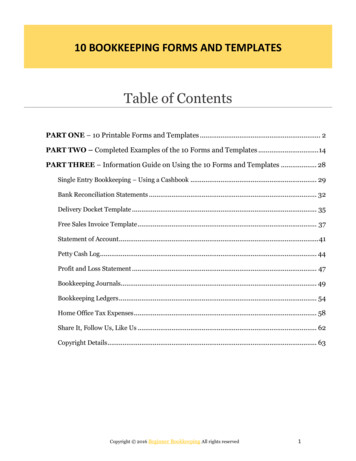
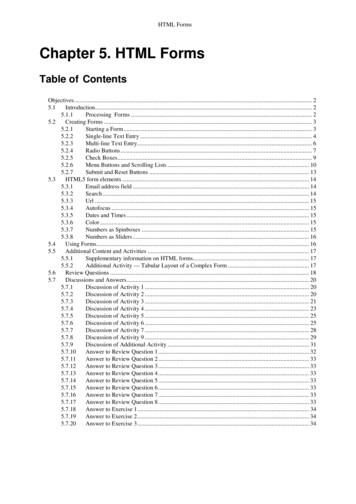
![[MS-OFBA]: Office Forms Based Authentication Protocol](/img/3/ms-ofba.jpg)

